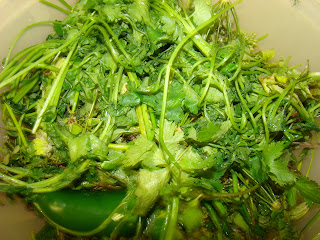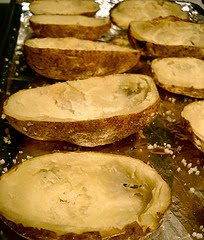













My 8 year old (soon to be 9) nephew was so very proud of his mini crop of all the herbs from his garden. He collected them in 2 zip lock bags and gave it to me "Jiji masi, I really don't know what to do with these, but they smell good and may be you can make something for your blog, I have chives, oregano, and "Variyari" (Gujrati for Fennel)".
I said, sure dear, I have been thinking of posting a recipe for different variations of Pesto and this would be a perfect time. Of course this recipes is totally different from the the traditional one, but "different is good".
Let me tell you little bit about Pesto and its history first.
Pesto is a sauce originating in Genoa in the Liguria region of northern Italy (pesto alla genovese), and traditionally consists of crushed garlic, basil and pine nuts blended with olive oil and Parmigiano Reggiano e Fiore Sardo (pecorino sardo).
The name is the contracted past participle of the Genoese word pestâ (Italian: pestare), which means to pound, to crush, in reference to the original method of preparation, with marble mortar and wooden pestle. However, the ingredients in a traditionally made pesto are not "pounded" but "ground" with a circular motion of the pestle in the mortar. This same Latin root through Old French also gave rise to the English word pestle.
History:
The ancient Romans ate a cheese spread called moretum, which may sometimes have been made with basil. The herb likely originated in North Africa; however, it was first domesticated in India. Basil took the firmest root in the regions of Liguria, Italy and Provence, France.
The Ligurians around Genoa took the dish and adapted it, using a combination of basil, crushed garlic, grated hard cheese (a mix of parmigiano-reggiano and pecorino or just one of the two), and pine nuts with a little olive oil to form pesto. In French Provence, the dish evolved into the modern pistou, a combination of basil, parsley, crushed garlic, and grated cheese (optional). However, pine nuts are not included.
In 1944, The New York Times mentioned an imported canned pesto paste. In 1946, Sunset magazine published a pesto recipe by Angelo Pellegrini. Pesto did not become popular in North America until the 1980s and 1990s.
Pesto is traditionally prepared in a marble mortar with a wooden pestle. First garlic and pine nuts are placed in the mortar and reduced to a cream, then the washed and dried basil leaves are added with coarse salt and ground to a creamy consistency. Only then is a mix of Parmigiano-Reggiano e Pecorino added. To help to incorporate the cheese a little extra-virgin olive oil is added. In a tight jar (or simply in an air-tight plastic container), covered by a layer of extra-virgin olive oil, pesto can last in the refrigerator up to a week, and can also be frozen for later use.
Pesto is commonly used on pasta, traditionally with Mandilli de Sæa (Genovese dialect - literally "silk handkerchiefs"), trofie or trenette. Potatoes and little green beans are also traditionally added to the dish , boiled in the same pot in which the pasta has been cooked. It is sometimes used in minestrone. Pesto is sometimes served on sliced beef, tomatoes and sliced boiled potatoes.
Because pesto is a generic term for anything that is made by pounding, there are various other pestos, some traditional, some modern. For this reason, the original (and most common) pesto is now called pesto alla genovese or pesto genovese (both forms are used in both English and Italian), in order to help differentiate the original basil based pesto from alternatives[citation needed].
Pesto alla genovese is made with Genovese basil, salt, garlic, Ligurian extra virgin olive oil (Taggiasco), European pine nuts (sometimes toasted) and a grated cheese like Parmigiano Reggiano or Grana Padano and pecorino Sardo or pecorino romano).
A slightly different version of the sauce exists in Provence, where it is known as pistou. In contrast with pesto genovese, pistou is,in general, made with olive oil, basil, and garlic only: While cheese may be added, usually no nuts are included. Pistou is used in the typical soupe au pistou, a hearty vegetable soup with pistou flavour. The sauce did not originally contain basil, however. Instead, cheese and olive oil were the main constituents.
Sometimes almonds are used instead of pine nuts, and sometimes mint leaves are mixed in with the basil leaves.
Pesto alla siciliana, sometimes called pesto rosso (red pesto), is a sauce from Sicily similar to pesto genovese but with the addition of tomato, almonds instead of pine nuts, and much less basil. Pesto alla calabrese is a sauce from Calabria consisting of (grilled) bell peppers, black pepper and more; these ingredients give it a distinctively spicy taste.
Outside Italy, the household name "pesto" has been used for all sort of cold sauces or dips mostly without any of the original ingredients: arugula (instead of or in addition to basil), black olives, lemon peel, coriander, or mushrooms. A German variety uses ramson leaves instead of basil.
In the 19th century, Genovese immigrants to Argentina brought pesto recipes with them. A Peruvian variety, known as "tallarines verdes" (meaning green noodles, from Italian tagliarini), is slightly creamier, lacks pine nuts (because of their rarity and prohibitive cost in Peru), may use spinach and vegetable oil (in place of olive oil), and is sometimes served with roasted potatoes and sirloin steak.
Lots of industrially made Pestos use cashew nuts.
Pesto in the US is commonly available in supermarkets in either green (original) or red (with sun-dried tomatoes or red bell peppers) varieties, produced by major manufacturers or under a generic or cheaper brand. Cashew nuts, walnuts or Chinese pine nuts are often used instead of European pine nuts, because they are less expensive and have a similar texture (although not the same taste). Cheaper oils and other herbs, like parsley, may also be used to further reduce the price.
In Singapore, an Italian-Peranakan fusion version called laksa pesto is popular. The recipe has the flavour of the local curry noodle soup, laksa but is made using the pesto method.
Vegan variations of pesto can include mixes of fresh basil, nuts such as walnut or pine nut, olive oil, and the addition of miso paste and nutritional yeast to provide additional flavor enhancement to the dish.
Here is how I made it this time.
Ingredients:
* Blend of herbs given to me by my nephew (Oregano, Chives, and Fennel) ~ 2 cups Washed and use only leafy part, discard the stems. (it was mainly oregano and chives and few sprigs of fennel)
* 2 cups of Cilantro leaves
* 1 cup of basil leaves
* 2-4 Jalapeno peppers (to taste)
* 10-12 cloves of garlic
* 3/4 cup of Almonds (I did not have pine nuts handy)
* 1/4 cup of Lemon juice (or to taste)
* 1/3 cup of Greek or home made plain yogurt (I substituted yogurt for Parmesan cheese, since I did not have it and I don't particularly care for the taste of Parmesan cheese)
* 1/3 cup of Olive oil
* Salt and pepper to taste.
Method:
The entire recipe is prepared by my Cuisinart food processor.
* First, toast the almond on griddle on stove, let them cool.
* Place the almond in food processor and blend them with maximum speed until they are in fine powder form.
* Add the all the ingredients except olive oil.
* Blend chop everything in the food processor until smooth.
* Finally add the olive oil.
* Taste is and see if it needs more salt/pepper or lemon juice.
Hints:
You can use the this pesto on Gnocchi, Pasta on any sandwiches or just use it as a dip with warm Italian bread.
If you don't have almonds or pine nuts, you can use Cashew nuts or even peanuts.
You can keep pesto up to 1 week in the fridge, but if you want to keep it longer, you can put the pesto into the ice cubes support and freeze it. When you need the pesto you can thaw the cubes of add them to the pasta or gnocchi recipe that you are cooking.
Information of Pesto and Basil pic Source: http://en.wikipedia.org/wiki/Pesto
http://en.wikipedia.org/wiki/Wikipedia:Text_of_Creative_Commons_Attribution-ShareAlike_3.0_Unported_License
Potted plant pic source: meganpru at http://www.flickr.com/photos/15215510@N00/2576774440
http://creativecommons.org/licenses/by-nc/2.0/deed.en
Pesto gnocchi pic by blue.tofu at http://www.flickr.com/photos/9064394@N02/2050768153/
http://www.flickr.com/photos/9064394@N02/2050768153/
Recipe and Rest of the Photographs by Surekha.
Thank you Vardaan for your inspiration for this recipe and sharing your herbs with Jijimasi :)











